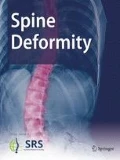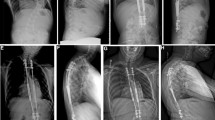Abstract
Study design
Retrospective, multicenter.
Objective
To investigate clinical outcomes in particular T1–S1 growth in patients with SHILLA instrumentation independent of inventor’s reports.
Summary
Guided growth with apical fusion and sliding pedicle screws (GGC/SHILLA) is an alternative to distraction-based growing rods for the treatment of EOS. A recent report of patients treated with GGC primarily at the center where the procedure was invented reported surprisingly good spinal growth similar to normal growth.
Methods
Retrospective review of EOS patients treated with GGC between 2007 and 2013 was performed from a multicenter database prior to final fusion. Inclusion criteria were < 10 years at index surgery and minimum 2-year follow-up. Patients with GGC performed at the inventor’s institution or prior spinal instrumentation were excluded. Predicted normal T1–S1 change during the growth period was calculated for each patient based on Dimeglio’s growth rates.
Results
20 patients (mean age at surgery: 5.7 years) with the following diagnoses met inclusion criteria: syndromic (N = 9), neuromuscular (N = 5), idiopathic (N = 3) and congenital (N = 3). Preoperative mean Cobb was 77° (range 33°–111°). Mean increase in T1–S1 length from preoperative to postoperative was 51.5 mm, and change from postoperative to final follow-up was 21.8 mm (4.2 mm/year) which was 36% of predicted growth. 15/20 (75%) patients underwent 21 revision surgeries most commonly for implant complications (N = 26) and 8/20 (40%) underwent definitive fusion at a mean of 5.1 ± 1.2 years after guided growth surgery.
Conclusion
This study constitutes the largest case series of patients with EOS treated with GGC outside of the inventor’s institution. The change in T1–S1 observed through the follow-up period in EOS patients treated with GGC was approximately 1/3rd of predicted normal growth, and less than 1/3rd of growth reported in previous reports. Similar curve correction and complication rates but less T1–S1 growth during the growth period were found compared to prior GGC (SHILLA) series.
Similar content being viewed by others
References
Karol LA, Johnston C, Mladenov K, Schochet P, Walters P, Browne RH (2008) Pulmonary function following early thoracic fusion in non-neuromuscular scoliosis. J Bone Joint Surg Am 90(6):1272–1281
Williams BA, Matsumoto H, McCalla DJ, Akbarnia BA, Blakemore LC, Betz RR et al (2014) Development and initial validation of the classification of early-onset scoliosis (C-EOS). J Bone Joint Surg Am 96(16):1359–1367
Fernandes P, Weinstein SL (2007) Natural history of early onset scoliosis. J Bone Joint Surg Am 89(Suppl 1):21–33
Murphy RF, Moisan A, Kelly DM, Warner WC, Jones TL, Sawyer JR (2016) Use of vertical expandable prosthetic titanium rib (VEPTR) in the treatment of congenital scoliosis without fused ribs. J Pediatr Orthop 36(4):329–335
Akbarnia BA, Marks DS, Boachie-Adjei O, Thompson AG, Asher MA (2005) Dual growing rod technique for the treatment of progressive early-onset scoliosis: a multicenter study. Spine 30(17S):46–57
Miladi L, Journe A, Mousny M (2013) H3S2 (3 hooks, 2 screws) construct: a simple growing rod technique for early onset scoliosis. Eur Spine J 22(2):96–105
Upasani VV, Parvaresh KC, Pawelek JB, Miller PE, Thompson GH, Skaggs DL et al (2016) Age at initiation and deformity magnitude influence complication rates of surgical treatment with traditional growing rods in early-onset scoliosis. Spine Deform 4(5):344–350
Mineiro J, Weinstein SL (2002) Subcutaneous rodding for progressive spinal curvatures: early results. J Pediatr Orthop 22(3):290–295
Luhmann SJ, McCarthy RE (2017) A comparison of shilla growth guidance system and growing rods in the treatment of spinal deformity in children less than 10 years of age. J Pediatr Orthop 37(8):567–574
McCarthy RE, Luhmann S, Lenke L, McCullough FL (2014) The Shilla growth guidance technique for early-onset spinal deformities at 2-year follow-up: a preliminary report. J Pediatr Orthop 34(1):1–7
Dimeglio A, Canavese F (2012) The growing spine: how spinal deformities influence normal spine and thoracic cage growth. Eur Spine J 21(1):64–70
Akbarnia BA, Pawelek JB, Cheung KM, Demirkiran G, Elsebaie H, Emans JB et al (2014) Traditional growing rods versus magnetically controlled growing rods for the surgical treatment of early-onset scoliosis: a case-matched 2-year study. Spine Deform 2(6):493–497
Luhmann SJ, Smith JC, McClung A, McCullough FL, McCarthy RE, Thompson GH (2017) Radiographic outcomes of shilla growth guidance system and traditional growing rods through definitive treatment. Spine Deform 5(4):277–282
Funding
No external funding was secured for this study.
Author information
Authors and Affiliations
Consortia
Contributions
AN Data collection, data analysis, manuscript preparation/review, final approval of manuscript; DLS Study idea, study design, manuscript review, final approval of manuscript; KDI Data analysis, manuscript review, final approval of manuscript; SP Data collection, manuscript review, final approval of manuscript; SAS, JS, Growing Spine Study Group Data collection, manuscript review/revision, final approval of manuscript; LMAStudy idea, study design, manuscript review/revision, final approval of manuscript.
Corresponding author
Ethics declarations
Conflict of interest
The authors declare that they have no conflict of interest.
Ethical approval
This study has been carried out with approval from the Committee on Clinical Investigations at Children’s Hospital Los Angeles.
Additional information
Publisher's Note
Springer Nature remains neutral with regard to jurisdictional claims in published maps and institutional affiliations.
Rights and permissions
About this article
Cite this article
Nazareth, A., Skaggs, D.L., Illingworth, K.D. et al. Growth guidance constructs with apical fusion and sliding pedicle screws (SHILLA) results in approximately 1/3rd of normal T1–S1 growth. Spine Deform 8, 531–535 (2020). https://doi.org/10.1007/s43390-020-00076-7
Received:
Accepted:
Published:
Issue Date:
DOI: https://doi.org/10.1007/s43390-020-00076-7



